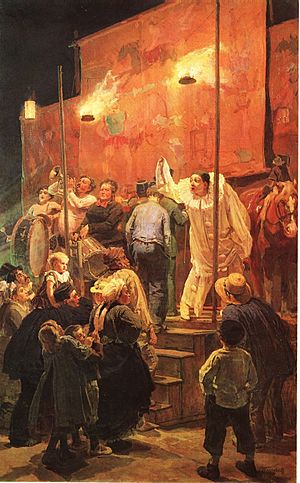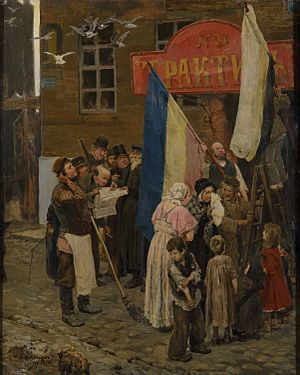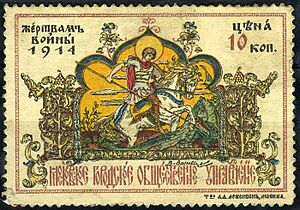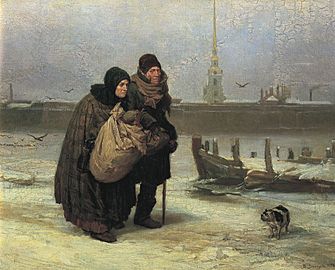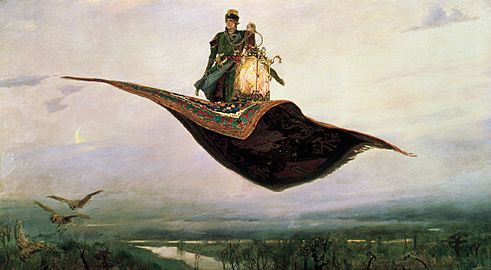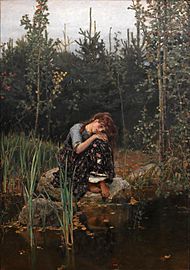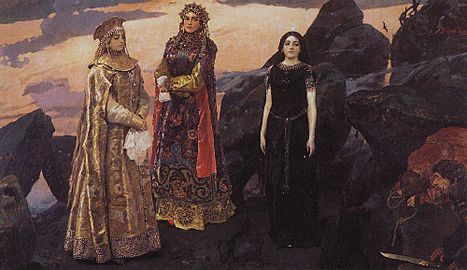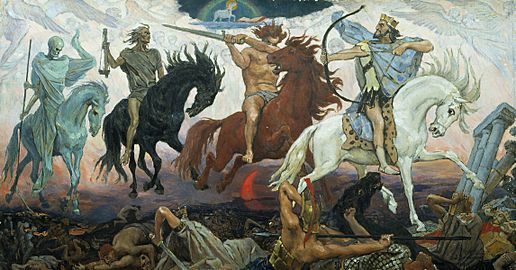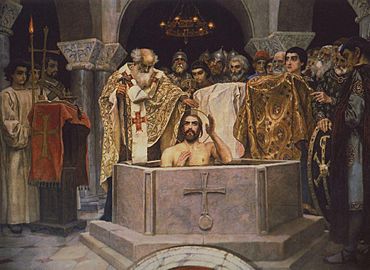Viktor Vasnetsov facts for kids
Quick facts for kids
Viktor Vasnetsov
|
|
|---|---|
| Виктор Васнецов | |
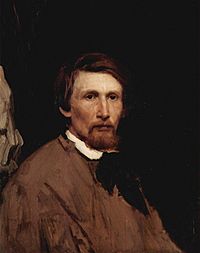
Self-portrait, 1873
|
|
| Born |
Viktor Mikhaylovich Vasnetsov
15 May 1848 Lopyal, Vyatka Governorate, Russian Empire
|
| Died | 23 July 1926 (aged 78) Moscow, Russian SFSR, Soviet Union
|
| Education | Imperial Academy of Arts |
| Known for | Painting |
|
Notable work
|
|
| Movement | Symbolism; History painting, Peredvizhniki |
| Patron(s) |
|
Viktor Mikhaylovich Vasnetsov (born May 15, 1848 – died July 23, 1926) was a famous Russian artist. He was known for his paintings about Russian myths, fairy tales, and history. Many people see him as a key artist in the Russian Revival movement. This movement brought back old Russian art styles and traditions.
Contents
The Early Life of Viktor Vasnetsov
Growing Up (1848–1867)
Viktor Vasnetsov was born in a small village called Lopyal in 1848. He was one of seven children. His father, Mikhail Vasilievich Vasnetsov, was a priest and loved to study nature and stars. Viktor's grandfather was an icon painter.
Two of Viktor's brothers, Viktor and Apollinary, became amazing painters. Viktor started painting when he was young. He mostly painted landscapes and scenes from village life. He said he loved playing with the local peasant children.
When Viktor was ten, he went to a special school called a seminary in Vyatka. Every summer, he moved with his family to a rich merchant village. During his school years, he worked for a local shop that sold icons. He also helped a Polish artist paint frescoes for a big church in Vyatka.
After finishing school, Viktor decided to become an artist. He sold two of his paintings to get money for his trip. He wanted to go to Saint Petersburg to study art.
Art School in Saint Petersburg (1867–1876)
In 1867, Viktor tried to get into the Imperial Academy of Arts but didn't succeed. He tried again a year later and got in!
Around this time, a group of students left the Academy. They felt the rules were too strict. This group became known as the Peredvizhniki. They were realist painters who wanted to show real life in their art.
Vasnetsov became friends with Ivan Kramskoi, a leader of the Peredvizhniki. He also became very close with another student, Ilya Repin.
Even though Viktor later became famous for historical and mythological paintings, he avoided these subjects at first. He won a small medal for a drawing of Christ and Pontius Pilate.
In the early 1870s, he made many engravings about everyday life. Two of his works won a bronze medal at a big fair in London in 1874. He also started painting everyday scenes in oil. People liked his paintings like Peasant Singers (1873).
Viktor Vasnetsov's Artistic Journey
Time in Paris (1876–1877)
In 1876, his friend Repin invited Vasnetsov to join other artists in Paris, France. While there, Viktor studied many different types of paintings. He looked at old classical art and newer styles like Impressionism.
During this time, he painted Acrobats (1877). He also started to become very interested in fairy tales. He began working on paintings like Ivan Tsarevich Riding a Grey Wolf and The Firebird. Vasnetsov even posed for his friend Repin's famous painting, Sadko. In 1877, he moved back to Moscow.
Moscow and Fairy Tales (1877–1884)
In the late 1870s, Vasnetsov focused on illustrating Russian fairy tales and epic poems called Bylinas. He created some of his most famous works during this period. These include The Knight at the Crossroads (1878) and Alionushka (1881).
At first, many art critics didn't like these paintings. They thought they went against the realistic style of the Peredvizhniki group. Even important art collectors didn't want to buy them. But in the 1880s, people started to love Vasnetsov's unique style. He then began painting religious subjects. He created many icons for his patron's estate, Abramtsevo.
Painting in Kiev (1884–1889)
From 1884 to 1889, Vasnetsov was asked to paint frescoes inside St Vladimir's Cathedral in Kiev. This was a very big and challenging project. His work was different from traditional religious paintings. Some critics didn't like them, but others praised them for bringing different parts of Russian society together.
While in Kiev, Vasnetsov became friends with another artist, Mikhail Vrubel. Vasnetsov taught the younger artist a lot. It was in Kiev that Vasnetsov finished Ivan Tsarevich Riding a Grey Wolf. He also started his most famous painting, the Bogatyrs.
In 1885, he traveled to Italy. That same year, he designed the sets and costumes for an opera called The Snow Maiden.
Later Years and Legacy
Later Life and New Designs (1890–1926)
The next twenty years were very busy for Vasnetsov. He started working in other art forms too. In 1897, he worked with his brother Apollinary to design sets for another opera, Sadko.
Around the year 1900, Vasnetsov developed his special "fairy-tale" style for buildings. This was part of the Russian Revival movement. His first famous building design was a church in Abramtsevo (1882). He worked on this with another artist, Vasily Polenov. In 1894, he designed his own home in Moscow. He also designed the Russian building for the World Fair in Paris in 1898.
In 1904, Vasnetsov designed the most famous of his "fairy-tale" buildings. This was the front of the Tretyakov Gallery, a famous art museum.
He also designed mosaics for churches in Warsaw and Moscow. In 1912, Czar Nicholas II gave him a special noble title. In 1914, he designed a special stamp to help raise money for people affected by World War I.
Before the Russian Revolution, Vasnetsov helped manage the Tretyakov Gallery. He gave a lot of his own money to the State Historical Museum. This helped the museum buy many important artworks. After the October Revolution, he suggested moving religious paintings from churches to the Tretyakov Gallery to protect them.
In 1915, Vasnetsov helped design a military uniform. He is known for creating the budenovka, a military hat that looked like old Russian helmets.
Viktor Vasnetsov died in Moscow in 1926. He was 78 years old.
Lasting Impact
A small planet in space, 3586 Vasnetsov, is named after Viktor Vasnetsov and his brother Apollinary. It was discovered in 1978.
In the movie Elizabeth: The Golden Age, one of Vasnetsov's paintings is shown. It's a painting of Ivan the Terrible. But in the movie, it's shown as if it existed much earlier than it really did.
Viktor Vasnetsov's grandson, Andrei, also became a famous artist.
Works
- Viktor Vasnetsov's works
-
Baptism of Prince Vladimir (1890)
-
Tsar Ivan the Terrible (1897)
See also
 In Spanish: Víktor Vasnetsov para niños
In Spanish: Víktor Vasnetsov para niños



